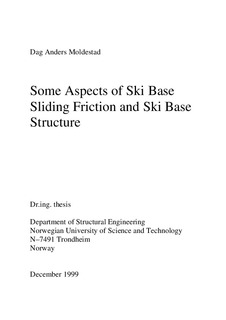| dc.description.abstract | The present work highlights some aspects of ski base sliding friction and ski base structure. Ski base structure causes speed differences that range from negligible to almost 10% of the skier speed. The great speed difference under som snow conditions makes the choice of the best structure an important issue for competition skiers and an interesting aspect to understand the physical processes that control friction against snow.
The thesis discusses and explains ski base sliding friction by use of tribology, impact and compaction resistances, electrical charging and electrostatic pressures. The optimum ski base structure roughness varies under different snow conditions according to the generated frictional water film thickness under the ski and the roughness of the snow surface. Thick water films correspond to course ski base structures, while it is advantageous to use finer ski bae structures and increase the water film thickness when th water film is thin. The possible increase of water film thickness along the ski implies an increase of the ski base structure roughness along the ski. Impact and compaction resistances are important when the snow hardness is below a certain limit, and when the water film thickness is low relative to the roughness of the ski base structure and the snow surface. The dry friction process is dominated and characterized electrically by accumulaltion of electrostatic charge in the ski base contact points. The frictional water film inititates discharge of potential differences between ski and snow due to the much higher electrical conductivity of water relative to snow. When the air gap volumes between the water film and the ski base structure, and the water film and the snow surface get small, the electrostatic pressures in the air gaps increase, and suction or drag may start occuring. The wet friction process is characterised electrically by electrolytic behavior. Further research is necassary in order to increase the knowledge and understanding of the simultaneous processes of mass, impulse, energy, electrical and chemical balances between the two interacting surfaces in relative motion during friction.
A Ski base Structure Analyser (SSA) utilising laser technology has been developed to analyse the detailed structure of a stone-fround ski base. The SSA displays the measured surface as an image with 739x570 pixels, where each pixel can have a grey level value from 0 to 255. The value of each pixel is proportional to the height at the corresponding point of the measured surface. In the period between 1995 and 1998 almost 1700 ski base structure measurements were performed on more than 350 skis. It was found that ski pairs ground with the "same" structure at two different times are not necassarily equal if no quality control of the ski base structure and the stone grinding process has been performed. On several competition ski pairs higher structure roughness (up to 84%) was revealed on the forebody than the afterbody of the ski. The work has resulted in develoment of ski base structures with increased roughness along the ski, developed and extreme optimisation of the best structures, and improvement of the frinding diamonds used to set the grinding stone. further, it has given ski technicians and competition skiers confidence in that optimum structures can be reproduced. The ski base structure roughness can be divided into four categories: fine (arithmetic mean roughness 1-4 µm), medium (arithmetic mean roughness 4-7 µm), course ( arithmetic mean roughness 7-10 µm) and very coarse ( arithmetic mean roughness higher than 10 µm) that correspond to dry to moist, moist, moist to wet, and wet to very wet snow conditions, respectively.
A structure test series consisting of ten ski pairs with eight different structures has been ground and quality-controlled. Accurate sliding tests showed that ski pairs with arithmetic mean structure roughness ≤ 5.4 µm were best under snow conditions with snow humidity ≤ 0.6%, snow temperatures below zero and new snow. A ski pair with arithmetic mean structure roughness equal to 9.3 µm was best under snow conditions with snow humidity between approximatly 0.3 and 4.0 %, snow hardness higher than 4.1x104 Pa and transformed snow types. Under snow conditions with snow humidity higher than approximately 4%, a structure with arithmetic mean roughness 12.7 µm was best. Coarser sructures were relatively better than finer structures at high speeds compared to low speeds, thus implying an increase in the water film thickness and optimum structure roughness with speed. A decrease of the structure roughness along the ski was unfortunate under most snow conditions.
Various snow parameters have been registered during measurement campaigns in ski tracks in Norway (1995-98), Hakuba/Japan (1996-98) and Sundance/USA (1999). Specific attention has been paid to snow hardness, snow humidity, snow density, snow grain structure and electrolytic conductivity. Snow hardness between 104 and 106 Pa is most common in ski tracks, and snow hardness below 105 Pa is likely to be present 60% of the time. The mean density of snow in ski tracks (0.50 g/cm3) is considerable higher than typical densities of seasonal snow covers (0.26-0.38 g/cm3) and higher for transformed snow types (0.51-059 g/cm3) than new snow types (0.39-0.43 g/cm3). The snow humidity in a ski track typically ranges between 0 and 12.5%. It is typically less than 2% for snow temperatures below -2 °C and less than 1% for snow temperatures below -7°C. Snow humidities exceeding 4% have only been registered at air temperatures above +1°C. High electrolytic conductivities (61.7 µS/cm and 94.5 µS/cm, respectively) and high levels of Na+- and C1--ions have been registered in melted snow samples from Trondheim and Sundance/Heber due to salt being a major agent during snow nucleation in the snowfalls. These values are approximately 3 times higher than the maximum values found for snow samples from Hakuba (21.9 µS/cm). The electrolytic conductivity of a melted snow sample may indicate the rate of ions introduced th the interface between snow and ski by frictional melting and thereby the rate and ease of discharge between ski and snow through the frictional water film during skiing. | nb_NO |
